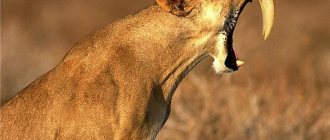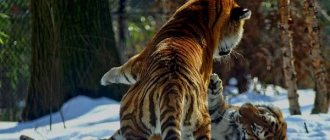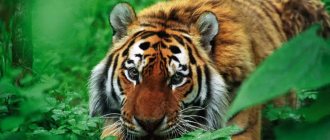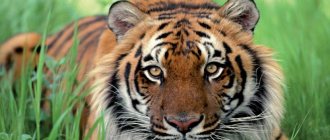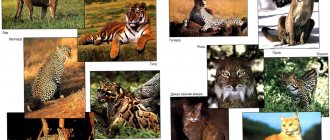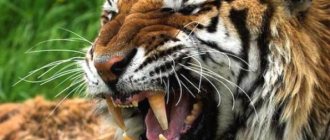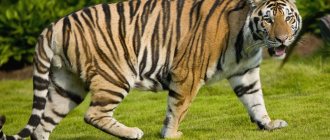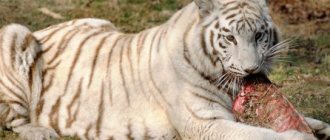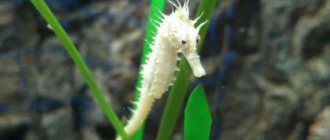Surely, each of us has watched the animated film Ice Age. That's why everyone knows Diego, the saber-toothed tiger, one of the representatives of the cat family. Smilodon is a family of domestic cats that we can currently find in most of our homes. Although the saber-toothed tiger is completely extinct, its image based on archaeological excavations today scares people like in the best horror films.
Smilodon in Greek means “knife tooth.” A name that was given to him due to the presence of very large fangs. This prehistoric cat belongs to an extinct species that lived from about 3 million to 10 thousand years ago in North and South America. These extinct large predators are also placental mammals.
source
Kinds
The species are known as saber-toothed tigers or saber-toothed cats. Researchers discovered and described the remains, and on their basis they identified 6 species, all of which became extinct a long time ago, these are:
- Smilodon fatalis (1.6 million - 10 thousand years ago),
- Smilodon gracilis (2.5 million - 500 thousand years ago),
- Smilodon populator (1 million – 10 thousand years ago),
- Smilodon neogaeus (3 million – 500 thousand years ago),
- Smilodon floridus (suggested that it may have been a subspecies of S. fatalis and lived at the same time),
- Smilodon californicus (suggested that it could also be a subspecies of S. fatalis).
size comparison of Smilodonów - Smilodon populator (green), S. fatalis (purple), and S. gracilis (orange) with a human. One grid is 1 meter.
As you can see, the period of reign of these tigers was the Pleistocene. The so-called “age of the great marine mammals” continued on earth, in which the main representatives were also such species of mega fauna as: the woolly mammoth (Mamuthus primigenius), the hairy rhinoceros (Coleodonta antiqitatis), the cave bear (Ursus spelaeus) and the giant deer ( Megaloceros giganteus).
Cat sizes
These were the largest cats in the history of the earth. A fully mature cat weighed, depending on the species, from 55 approx. 400 kg. The largest species was Smilodon populator, which reached up to 1.2 meters in height at the withers, weighing up to 400 kg. This species lived in the eastern regions of the North American continent. Smilodon gracilis is considered the smallest tiger species. Scientists claim that it was close in size to a leopard, reaching a weight of 100 kg.
After the connection of North and South America, tigers spread to both continents. For the Indians, this was the New World, because they migrated from the territory of modern northern Asia (Siberia). After some time, people and these huge predators lived together in the same territory. Then these cats became extinct forever. The last fossil remains of Smilodon found in North and South America are estimated at 11-9 thousand. years.
Appearance of saber-tooths
Saber-toothed tigers had a short tail, powerful limbs and a large head. They were similar in size to today's lions, although the largest of the species, Smilodon populator, was significantly larger. The tigers were extremely strong. The tiger's jaw grip angle was up to 120 degrees, and its fangs were the longest of any cat in history - on average 17 cm in length. (and up to 28 cm in the largest species Smilodon populator). The fangs are adapted for tearing animals. Due to weak jaw muscles, the bite is 3 times weaker than a lion's bite.
The strength of the power depended more on the muscles of the neck and back of the head than on the jaws. Sabertooths had a muscular neck, powerful legs (especially the hind legs), and, unlike modern tigers, a short tail. The tiger also had a denser body structure than today's big cats, and its lumbar region was proportionately short and slightly sloped, like those of hyenas. The front legs are noticeably longer than the hind legs, and the back along the shoulder-hip line is inclined down towards the lower back.
Like most cats, these huge predators must also have been able to hide their claws. Sabretooth was not a very good runner and preferred to ambush his prey rather than chase it. This body structure was necessary to impart greater strength, not speed.
Saber-toothed tigers - family lifestyle
The social image of these cats is poorly known. However, there are numerous archaeological clues regarding their way of life. It is assumed that they may have quite complex social behavior. This tiger was most likely a herd animal. The wounded animals were fed in the pack by other relatives. Scientists believe that their main prey were buffalos, camels and deer, which were very numerous at that time in America, as well as giant ground sloths.
And in America, smilodon could hunt horses and llamas. It is possible that they hunted mastodons and mammoths. It is also believed that saber-toothed tigers were scavengers, who, hearing the desperate calls of wounded animals, hurried to feast on them.
Tigers lived and hunted in groups, and also provided food for young, sick and old individuals. Living in a pack may also have helped it compete effectively with other lions and wolves. It is also worth noting that males and females had fangs of the same size (no visible sexual dimorphism). This suggests that the theory that these teeth served to attract a mate is wrong.
When and why did saber-tooth tigers become extinct?
Cats became extinct about 10 thousand years ago. At this time, they were already dead, as was all the fauna of that time, including mammoths, giant deer and ground sloths. Currently, the cause of extinction is considered to be lack of nutrition, due to the disappearance of large game species of these big cats. Saber-tooth tigers could not adapt to hunting small animals because they were too massive and heavy, and also too slow. There is also a theory that oversized tusks may have hampered hunting of small animals. Hypothetically, climate change at that time, as well as diseases, could have influenced extinction. Also, people arrived in America (80% of large mammal species became extinct in America within a thousand years after people arrived here).
Saber-toothed tiger - Smilodon: 10 interesting facts
The tiger is a very interesting creature, which is why we want to devote a few words to it. We will present to you some interesting facts about this now extinct feline species.
The main distinguishing feature of the saber-toothed tiger were its fangs. Their length reached approximately 30 centimeters, and caused horror in many animals.
Compared to large cat species living today, the strength of Smilodon's jaws was truly great.
Their jaw opening reached 130 degrees. For comparison, a lion can open its jaw up to 65 degrees.
According to recent research by scientists, tigers of this species, unlike most cats, lived in herds.
Tigers' fangs were very prone to fractures. To avoid such a situation, saber-tooth tigers grabbed their opponents with the help of their strong, muscular front paws.
At one time, these huge predators ate about 30 kilograms of meat.
There are many theories about the extinction of this species. Among them is an infectious disease that has attacked this species. And also the inability to hunt small and fast mammals.
The tigers' diet consisted mainly of the meat of small mammals. They also hunted young mammoths. There are also rumors that people were also the target of their attacks, but there is no concrete evidence.
The time of extinction of this species is estimated at about 10 thousand years ago.
Currently, the image of these animals is often used in culture. An example of this is the already mentioned Diego from the Ice Age.
Interesting for you:
Appearance
One can only guess what the animal saber-toothed tiger actually looks like, because the image created by scientists is very conventional. In the photo, the saber-toothed tiger does not look at all like living representatives of the cat family. Large fangs and bear proportions make it unique and one of a kind. The dimensions of a saber-toothed tiger are comparable to the linear parameters of a large lion.
- Body length 2.5 meters, height at withers 100 - 125 cm.
- The unusually short tail had a length of 20 - 30 cm. This anatomical feature deprived predators of the ability to run quickly. When turning at high speed, they could not maintain balance, maneuver and simply fell.
- The weight of the animal reached 160 - 240 kg. Large individuals from the species Smilodon populator exceeded the weight of the Bengal and Amur tigers and had a body weight of 400 kg. The predator was distinguished by a powerful wrestling physique and awkward body proportions.
- In the photo, saber-toothed cats have well-developed muscles, especially on the neck, chest and paws. Their forelimbs are longer than their hind limbs, and their wide feet end in sharp retractable claws. A saber-toothed cat could easily grab an enemy with its front paws and throw him to the ground as best he could.
- The saber-toothed tiger's skull was 30 - 40 cm in length. The frontal and occipital parts are smoothed, the massive facial part is extended forward, the mastoid process is well developed.
- The jaws opened very wide, almost 120 degrees. Special attachment of muscles and tendons made it possible to press the predator's upper jaw to the lower jaw, and not vice versa, as in all modern cats.
- The upper fangs of the saber-toothed tiger protruded 17 - 18 cm from the outside, their roots penetrated into the bones of the skull almost to the very eye sockets. The total length of the fangs reached 27 - 28 cm. They were compressed from the sides, well sharpened at the very ends, pointed in front and behind, and jagged. The unusual structure allowed the fangs to damage the thick skin of animals and bite through flesh, but deprived them of strength. If they hit the bones of the victim, the fangs could easily break, so the success of the hunt always depended on the correctly chosen direction and accuracy of the blow.
- The predator's skin has not been preserved and its color can only be established hypothetically. The color most likely was a camouflage device, and therefore corresponded to the habitat. It is quite possible that during the Paleogene period the fur had a sandy-yellow tint, and during the Ice Age only the white saber-toothed tiger was found.
Appearances
- "The Wizard of Oz"
- "Oorfene Deuce and his wooden soldiers"
- "Seven Underground Kings" (Mentioned only)
- "Fire God of the Marrans"
- "Yellow Fog"
- The Mystery of the Abandoned Castle (Picture only)
Saber-toothed tigers. Ill. Victor Bakhtin.
Saber-toothed tigers fall into the gorge. Ill. Viktor Chizhikov.
Saber-toothed tigers. Illustration by Yulia Gabazova.
Sabretooths are preparing to jump. Artist Angelina Kankava.
A. Volkov. The Wizard of Oz. Sketch of a doll. Saber-toothed tiger. 1991
Saber-toothed tiger. The Wizard of Oz. Cartoon(1973-1974)
Drawing of a saber-toothed tiger. Ill. Leonid Vladimirsky
Saber-toothed tigers. Ill. Vladimir Kanivets
Saber-toothed tigers. Ill. A. Vlasova
Lion vs saber tooth tiger. Illustration by Oleg Gorbushin.
Saber-toothed tigers fall into a ravine. Ill. Chukavina Alexandra and Chukavina Irina
Saber-toothed tigers. The Wizard of Oz (film) 1994
Lion vs saber-toothed tigers. Artists Chukavin Alexander, Chukavina Irina.
Saber-toothed tigers fall into a ravine. Ill. O. Goryunova
Saber-toothed tigers. Ill. Alexandra Shahgeldyan
Add photo to gallery
Kinds
- The species Smilodon fatalis appeared on the American continents 1.6 million years ago. It had average size and weight, comparable to the weight of a modern tiger - 170 - 280 kg. Its subspecies include Smilodon californicus and Smilodon floridus.
- The species Smilodon gracilis lived in the western regions of America.
- The Smilodon populator species was distinguished by its largest size, had a stocky build, and exceeded the weight of the largest tigers. Effectively killed the victim by cutting the carotid artery and trachea with sharp fangs.
Mahayrods
Of all the representatives of saber-toothed cats known to science, it was the Mahairod that most closely resembled a tiger. In nature, there were several types of mahairods, which had significant differences in appearance, but they were united by the jagged edges of long upper fangs, shaped like “mahairs” - curved swords.
These ancient animals appeared in Eurasia about fifteen million years ago, and two million years have passed since their extinction. The weight of the largest representatives of this tribe reached half a ton, and in size they were quite comparable to modern horses.
Archaeologists are convinced that the Machairod was the largest wild cat of its time. Hunting large herbivores - rhinoceroses and elephants, these animals quite successfully competed with other large predators of their time, dire wolves and cave bears. Machairods became the “progenitors” of a more advanced type of saber-toothed cat – Homotherium.
- 32 facts about tigers
- Weasel
- Whale shark
- 34 facts about raccoons
- Maned wolf
- Nettle
Homotherium
It is believed that these saber-toothed cats appeared about five million years ago at the boundary of the Miocene and Pleistocene. They were distinguished by a more slender physique, vaguely reminiscent of a modern lion. However, their hind legs were somewhat shorter than their front legs, which gave these predators some resemblance to a hyena. The upper fangs of Homotherium were shorter and wider than those of Smilodon - representatives of another tribe of saber-toothed cats that inhabited the Earth in parallel with them. Along with this, the presence of a large number of notches on the fangs allowed scientists to conclude that these animals were capable of delivering not only slashing, but also cutting blows.
Compared to other saber-toothed cats, Homotherium had very high endurance and was adapted to long (although not fast) running and walking over long distances. There are suggestions that these now extinct animals led a solitary lifestyle. However, most researchers are still inclined to believe that homotherium hunted in groups like other saber-toothed cats, since it was easier to kill stronger and larger prey.
Smilodon
Compared to other saber-toothed cats that the ancient animal world of the Earth knew, Smilodon had a more powerful physique. The largest representative of saber-toothed cats - Smilodon populator , which lived on the American continent - grew up to one hundred and twenty-five centimeters high at the withers, and its length from the nose to the tip of the tail could be two and a half meters. The fangs of this beast (along with the roots) reached twenty-nine centimeters in length!
Smilodon lived and hunted in prides, including one or two dominant males, several females and young animals. The coloration of these animals could well be spotted, like a leopard. It is also possible that the males had a short mane. Information about Smilodon is contained in many scientific reference books and fiction; it appears as a character in films (Jurassic Portal, Prehistoric Park) and cartoons (Ice Age). Perhaps this is the most famous animal of all, which is commonly called saber-tooth tigers.
The clouded leopard is a modern descendant of the saber-toothed tiger
Today it is believed that the clouded leopard is the indirect, but closest relative of Smilodon. It belongs to the subfamily Pantherinae (panther cats), within which it is classified into the genus Neofelis. Its body is quite massive and compact at the same time - these features were also inherent in the saber-toothed cats of antiquity. Among representatives of modern felines, this animal has the longest fangs (both upper and lower) relative to its own size. In addition, the jaws of this predator can open 85 degrees, which is much more than that of any other modern cat.
Although not a direct descendant of saber-toothed cats, the clouded leopard serves as clear evidence that the method of hunting using deadly “saber fangs” can well be used by a predator in modern times.
Convergent taxa
The term “saber-toothed cats” is often used to describe a large number of species that only have similar long fangs. Most of them acquired them in the course of their adaptation to the external environment and the conditions of hunting prey, but upon closer attention, great differences are revealed between them, especially when compared with real saber-tooths.
Although the last animals to possess saber-like fangs were mammals, the first to acquire such weapons were their ancestors—therapsids, beast lizards. For example, in the Gorgonops family there were genera such as Inostracevia, which had long fangs. True, their fangs were round in cross-section, not flattened.
The second to acquire similar fangs were Thylacosmila. Thylacosmils lived in South America before its reunification with North America and played the role of lions in the local ecosystem. They stand out among all mammals that had saber fangs. The peculiarity of these predators was that they were marsupials, which is why they are also called marsupial saber-tooth tigers. Despite some similarities with Smilodon, these animals belong to a completely different order: their fangs grew throughout their lives and had simply huge roots that reached the frontal part; on the lower jaw there were sheath-like “blades”, probably to protect the fangs when the mouth was closed. Thylacosmils became extinct shortly after the reunification of the Americas - it is believed that they could not withstand competition from the cats that came from the north.
Another group that had large fangs were the creodonts. True, the fangs of the macheroids belonging to them were much shorter and smaller than those of even average saber-toothed cats, in contrast to the powerful and long jaws. This detachment included hyaenodons, for example. All of them became extinct by the Miocene.
The fourth was the extinct family of Nimravids. Outwardly, they resembled Smilodon, although they were not their relatives. In terms of body structure, skull and fangs, true saber-toothed cats and nimravids are very similar, but in fact they are another example of convergent evolution. Nimravids evolved only from a common ancestor with true felids in the Middle Eocene about 50 million years ago (but no later than 43 million years ago) and belong to a different suborder of felids. True saber-toothed cats were much larger, stronger and had much longer teeth - with only a few exceptions.
The fifth place was barbourofelidae, another extinct family of cat-like predators. They arose in the early Miocene in Africa and survived until its end. Previously, scientists classified them as a subfamily of nimravids, but today they are classified as a separate family. The barburofelis had the longest fangs. Outwardly, they were similar to ancient cats, but unlike saber-toothed cats, they had less developed incisors, smaller eye sockets, and the lower jaws also had “sheaths”, like those of thylacosmils.
The sixth and so far last are the saber-toothed cats themselves.
Along with the mammoth, the saber-toothed tiger was one of the most famous megafauna mammals during the Pleistocene era. But did you know that this fearsome predator was only distantly related to the modern tiger, and its fangs were as fragile as they were long? In this article, you will discover 10 interesting facts about the saber-toothed tiger, illustrated with pictures and photos.
Paleontological finds
In 1841, the first report of a saber-tooth tiger appeared in the fossil record. Fossil remains were found in the state of Minas Geras in eastern Brazil, where Danish paleontologist and naturalist Peter Wilhelm Lund conducted excavations. The scientist studied and described the relics in detail, systematized the facts and identified the beast as a separate genus.
Rancho La Brea, located in a bitumen valley near the city of Los Angeles, is famous for many finds of prehistoric animals, including the saber-toothed cat. During glacial times, there was a black lake in the valley, filled with a composition of thickened oil (liquid asphalt). A thin layer of water collected on its surface and attracted birds and animals with its shine.
The animals went to water and ended up in a death trap. All you had to do was step into the fetid mud and your feet themselves would stick to its surface. Under the weight of their bodies, the victims of optical illusion gradually sank into the asphalt, from which even the strongest individuals could not get out. The game bound by the lake seemed like easy prey for predators, but as they made their way to it, they themselves found themselves trapped.
In the middle of the last century, people began to extract asphalt from the lake and unexpectedly discovered there many well-preserved remains of animals buried alive. More than two thousand skulls of saber-toothed cats were raised outside. As it turned out later, only young individuals fell into the trap. Apparently the old animals, already taught by bitter experience, avoided this place.
Scientists from the University of California began studying the remains. Using a tomograph, the structure of the teeth and bone density were determined, and a number of genetic and biochemical studies were carried out. The skeleton of a saber-toothed cat was restored in great detail. Modern computer technology has helped to recreate the image of the animal and even calculate the force of its bite.
StrengthEdit
Sabertooth's Strongest Five
In X791, Sabertooth is considered the strongest guild in the kingdom of Fiore. This guild is superior in strength to many other guilds such as Lamia Scale, Blue Pegasus, and even the once legendary Fairy Tail, which was an underdog at the time. It is known that the most important members in the guild are the five strongest Mages. The guild also includes Sting Eucliffe and Rogue Cheney, who form the team Two Dragons of Sabertooth and are the only Third Generation Dragon Slayers of their kind, thanks to the Lacrima of their Dragons. Their strength was confirmed by the King of Fiore himself, who postponed the meeting with them to a later date. They claim that they were able to kill the Dragons who raised them. Other Mages of Sabertooth's "elite" group, such as Rufus Lore and Orga Nanagear, possess very rare types of Magic such as Memory-Make and Thunder God Slayer Magic. When Team Sabertooth took part in the Grand Magic Games, they were the first to pass the Sky Labyrinth qualifying test, beating such powerful Mages as Jura Nekis and Laxus Dreyar. It is also worth noting that it was not always in full force: at first, member Minerva Orland was replaced by Yukino Agria, who was new to the guild.
Lifestyle and behavior
The ancient saber-toothed tiger is a representative of a completely different era and, in its behavior, bears little resemblance to modern cats. It is possible that the predators lived in social groups, which included three to four females, several males and young individuals. It is possible that the number of females and males was equal. By hunting together, animals could catch larger game, which means they could provide themselves with more food.
These assumptions are confirmed by paleontological finds - several skeletons of cats were often found near one skeleton of a herbivore. An animal, weakened by injuries and diseases, with such a lifestyle could always count on a portion of the prey. According to another theory, the tribesmen were not distinguished by nobility and ate a sick relative.
Habitat of the saber-toothed tiger
Saber-toothed tigers dominated the territories of modern South and North America for quite a long time since the beginning of the Quaternary period - the Pleistocene. In much smaller quantities, the remains of saber-toothed tigers have been found on the continents of Eurasia and Africa.
Their habitat was areas with low vegetation, similar to modern savannas and prairies. How saber-toothed tigers lived and hunted in them can be seen in the pictures .
Hunting
For thousands of years, the predator specialized in hunting animals with thick skins. Having fangs capable of piercing their thick skin, he created real terror during the Ice Ages. The small tail did not allow the animal to develop high speed and hunts fast-running game, so its victims were clumsy, massive herbivorous mammals.
The ancient saber-toothed tiger used cunning techniques and got as close to its prey as possible. The victim was almost always taken by surprise, quickly attacked and used real wrestling techniques. Thanks to the special structure of the paws and the well-developed muscles of the anterior shoulder girdle, the animal could hold the animal motionless with its paws for a long time, running its sharp claws into it and tearing the skin and flesh.
The speed and accuracy of the attack, and the minimum noise during the attack increased the chances of the saber-toothed cat eating its trophy on its own. Otherwise, larger predators and packs of wolves would come running to the battlefield - and here you had to fight not only for your prey, but also for your own life.
The extinct saber-toothed cat ate exclusively animal food, was not known for moderation in food, and could eat 10–20 kg of meat at a time. Its diet included large ungulates and giant sloths. Favorite food: bison, mammoths, horses.
There is no reliable information about the reproduction and care of offspring. Since the predator belongs to the class of mammals, it can be assumed that its cubs fed on mother’s milk for the first month of life. They had to survive in difficult conditions and how many kittens survived to puberty is not known. The lifespan of the beast is also unknown.
Nutrition
Like all modern predators, they were carnivores. Moreover, they were distinguished by a great need for meat and in huge quantities. They hunted only large animals. These were prehistoric bison, three-toed horses, sloths and great proboscis.
Saber-toothed tigers could also a small mammoth . Small animals could not supplement the diet of this predator, because he could not catch them due to his slowness and eat them; large teeth would interfere with him. Many scientists argue that the saber-toothed tiger did not refuse carrion during a bad feeding period.
Puff adder
Most saber-toothed animals are extinct, but in modern times there is still a dangerous predator that uses huge fangs to defeat its prey, and it is the least known and strangest of them all. The African viper is a small snake from Africa that spends most of its life underground. She feeds primarily on rodents, which she defeats in fights with the help of her aforementioned fangs, which function as poisonous sabers that protrude from her mouth when used.
Unlike the sabers of previous animals, the snake's hiding teeth are flexible and can move, slithering so that the snake can strike its prey with one fang, and once it has killed its victim, it can use movable fangs
The venom is moderately strong, and since the snake can bite with its mouth closed, extra care is required when handling it. There are cases where people suffered after being bitten by an African viper; however, since these snakes rarely come out of their underground shelters, people rarely encounter these amazing creatures
The reason for the extinction of saber-toothed tigers
In recent years, information appears from time to time on the pages of scientific journals that residents of a certain tribe have seen animals described as similar to saber-toothed tigers. The natives even gave them a name - mountain lions. But there is no official confirmation that saber-toothed tigers are alive.
The main reason for the extinction of saber-toothed tigers was the changing Arctic vegetation. The main researcher in the field of genetics, professor at the University of Copenhagen E. Willerslev and a group of scientists from sixteen countries examined a DNA cell obtained from an ancient animal preserved in an ice floe.
From which the following conclusions were drawn: the grasses that horses, antelopes and other herbivores ate at that time were rich in protein. With the onset of the Ice Age, all vegetation froze.
After the thaw, the meadows and steppes turned green again, but the nutritional value of the new grasses changed; its composition did not contain the required amount of protein. This is why all artiodactyls became extinct very quickly. And they were followed in a chain by saber-toothed tigers, who fed on them, and were simply left without food, which is why they died of hunger.
In our time of high technology, with the help of computer graphics you can restore anything and go back many centuries. Therefore, in historical museums dedicated to ancient, extinct animals, there are many graphic pictures depicting saber-toothed tigers , which allow us to get to know these animals as much as possible.
Perhaps then, we will begin to appreciate, love and protect nature and saber-toothed tigers , and many other animals will not be listed on the pages of the Red Book as extinct species.
DescriptionEdit
Jiemma gathers everyone about Yukino's Expulsion
The former “strongest guild of Fiore,” under the control of Jiemma, was guided by strict principles: for any actions that disgrace the name of the guild, the offending Mage could receive a reprimand, and in the worst case, expulsion. Moreover, Jiemma could humiliate a person who displeased him, as seen during the incident with Yukino Agria, who was forced to disrobe in public and then expelled from the guild.
The guild consists of several dozen people, five of whom brought it fame. Unlike Fiore's former strongest guild, Fairy Tail, which accepted new members without any requirements, Sabertooth had high standards for those wishing to join the guild. This was mentioned by Yukino, who managed to join the guild only after several attempts. Despite this, the rather weak Exceeds, Lector and Frosh, are members of the guild, but Jiemma did not notice them point-blank until Lector spoke to him. This suggests that it is not only the Master who is responsible for accepting new members.
After the loss of the title of “strongest guild” and the happy return of Lector thanks to the efforts of the Fairy Tail Mages, the image of the merciless Sabertooth Tigers was forgotten. Currently, the guild moves forward, bound by bonds of friendship and trust.
Best articles: Natural areas of Russia: map, names, geographical characteristics and table
TOP 10 facts about the saber-toothed tiger
Along with the mammoth, the saber-toothed tiger was one of the most famous megafauna mammals during the Pleistocene era. But did you know that this fearsome predator was only distantly related to the modern tiger, and its fangs were as fragile as they were long? In this article, you will discover 10 interesting facts about the saber-toothed tiger, illustrated with pictures and photos.
1. The saber-toothed tiger was not the ancestor of the modern tiger
All modern subspecies of the tiger (Panthera tigris), for example, the Siberian tiger, belong to the genus Panthera (Panthera) from the subfamily of big cats (Pantherinae). Saber-toothed tigers, in turn, belong to the subfamily of saber-toothed cats (Machairodontinae), which became extinct at the end of the Pleistocene, which is only distantly related to modern lions, tigers, cheetahs and jaguars.
2. Smilodon was not the only genus of saber-toothed cats
Despite the fact that today the most famous genus of saber-toothed tigers is Smīlodōn, it was far from the only representative of the subfamily of saber-toothed cats. During the Cenozoic era, the subfamily included more than a dozen genera, including Megantereon, one of whose representatives is shown in the photo above. The classification of prehistoric cats is complicated by the fact that at that time the Earth was inhabited by cat-like mammals with similar anatomical features, but their relationship with saber-toothed tigers is highly doubtful in paleontological circles.
3. The genus Smilodon included three separate species
We know the least about the small (weighing up to 100 kg) species Smilodon gracilis, which lived in the western part of the United States between 2.5 million and 500 thousand years ago. Medium in size, but not well known among a wide range of people, Smilodon Fatalis lived in North and South America about 1.6 million to 10 thousand years ago. The largest member of the genus Smilodon was the species Smilodon populator, some individuals of which reached a mass of about 500 kg.
4. The fangs of the saber-toothed tiger were almost 30 cm long
No one would be interested in saber-toothed tigers if they looked like just big cats. What makes this megafauna truly worthy of attention? Of course, his huge fangs, which in large species reached a length of up to 30 cm. Oddly enough, these monstrous teeth were surprisingly fragile, easily broken during close combat and never grew back.
5. Saber-toothed tigers had weak jaws
The saber-toothed tiger could open its mouth like a snake at an angle of 120 degrees, which is about twice as wide as a modern lion (or a yawning house cat). Paradoxically, various species of Smilodon could not use such a swing to powerfully bite their prey, since they had to protect the precious fangs from unwanted damage (see previous paragraph).
6. A saber-toothed tiger was waiting for prey, hiding in a tree.
The long and fragile fangs of the saber-toothed tiger, combined with weak jaws, made their hunting style highly specialized. As far as paleontologists know, saber-tooth tigers pounced on their prey from the lower branches of trees, plunging their “sabers” deep into the neck of the unfortunate victim, and then retreating to a safe distance.
7. Saber-toothed tigers could live in packs
Many modern big cats have led paleontologists to suggest that saber-tooth tigers lived in packs. Evidence supporting this theory is evidence of old age and chronic disease on most Smilodon fossils. It is unlikely that sick and old individuals could survive in the wild without outside help, or at least the protection of other members of the pack.
8. Rancho La Brea is the richest source of fossil remains of saber-toothed tigers
Most fossils of dinosaurs and prehistoric animals have been discovered in remote areas of the planet, but thousands of saber-toothed tiger specimens have been recovered from remains found in tar lakes in Rancho La Brea, Los Angeles. Most likely, the prehistoric cats were attracted to other mammals stuck in the tar, which they considered an easy lunch.
9. The saber-toothed tiger had a stockier body than modern big cats.
Apart from the long saber-like fangs, there is another way to distinguish the saber-toothed tiger from modern big cats. They had thicker necks, broad chests and short muscular legs. The stocky body suited their lifestyle well, since they did not need to chase their prey through endless meadows, but only jump at it from the lower branches of trees.
10. The saber-toothed tiger became extinct 10,000 years ago Why did saber-tooth tigers disappear from the face of the Earth by the end of the last ice age? It is unlikely that primitive people had a direct connection to this. Most likely, a combination of climate change and the gradual disappearance of large mammals that served as prey led to their extinction. It is believed that intact DNA samples could be used to clone a saber-toothed tiger as part of a scientific program known as de-extinction.
Video
Lifestyle
White rhinos mostly live in small groups, but sometimes these groups can number up to 18 animals. Small herds mainly consist of females, their cubs and individuals that do not leave the adult females, but feed on their own.
Adult males sometimes join such groups. Females with cubs tolerate adult males only if he does not seek to mate. If the male is in a state of sexual hunting, then he is immediately expelled; there are cases where females even killed males. During this period, the male white rhino's sense of competition intensifies, so small rhinoceroses are in great danger. Aggression manifests itself in fierce fights between males; such fights are in no way reminiscent of the harmless tournaments of black rhinos. Sometimes the result of the battle can even be the death of one of the animals.
In case of threatening danger, mammals take a certain defensive position. Rhinoceroses stand in a circle, with their heads pointing outward. They cover defenseless cubs with their bodies.
Old males mark their territory, leaving an odorous composition on the bushes and grass where they graze.
The rhythm of life of animals mainly depends on weather conditions. In the sultry heat, white rhinoceroses seek refuge in the shade of spreading trees and come out to graze only at dusk, when the long-awaited freshness sets in. Sometimes they can graze all night. When the weather is cool and there is heavy rain, herds of animals seek protection in the bush. At average temperatures, rhinoceroses can graze during the day.
White rhinos need a permanent watering place, just like their black counterpart. In addition, animals need to regularly take mud baths. In the swimming areas, many swamp turtles are waiting for them, which act as orderlies, eating ticks that parasitize the skin of rhinoceroses.
Sexual maturity occurs at approximately 7-10 years of age. The breeding season is very poorly studied. From July to September is the rutting period, although exceptions have been observed. In one of the reserves in South Africa, it was found that the female carries the cub for about 18 months.
Most often, the female gives birth to one baby. It is worth noting that literally a day later the cub accompanies the mother, and after seven days it can eat grass, but continues to suck milk until it is one year old. In a healthy female, the interval between births is on average three years.
The white rhinoceros has a very keen sense of smell - this is the most developed of the senses. Hearing and poor vision play a minor role. A person can approach an adult animal at a distance of up to 30 meters, and the animal will not even notice him.
Many scientists and researchers are confident that the white rhinoceros is less aggressive than the black one. Representatives of the species most often run away from people without trying to attack, while the black rhino often attacks first, attacking the intruder.
NavigationEdit
| Teams | |
| Guild Teams | Thunderbolts • Team Natsu • Flying Dragon Squad • Falcon Squad • Shadow Gear • Two Sabertooth Dragons • Team Leon • Three Men |
| Dark Guild Teams | Shadow Gear of Edolas |
| Mercenary Guild Teams | |
| Treasure Hunter Guild Teams | |
| Gorichka Church | Legion unit |
| Kingdom of Fiore | White Tiger • Order of the Hungry Wolves • |
| Kingdom Stella | Army Kvartum • Three Stars |
| Alvarez Empire | 12 Spriggan • Azir's Squad • Brandish's Squad • Waru's Squad • Dimaria's Squad • Irene's Squad • Neinhart's Squad |
| Other Teams | Archaeological Society • Shaker Gang • Tit Shaker Gang • Flying Orca • Five Divine Dragons • Black Dragon Knights |
| Former Teams | |
| Disbanded Teams | 4 Elements • Crow Trinity • Nine Gate Demons • Team Dullahan Head • Team Jellal • Team Quattro Puppy • Team Makarov • Team Goblin Gear • Team Mermaid Heel • Team Sabertooth • Team Blue Pegasus • Team Scarmiglione • Team Rescue • Team Shadow Ogre • Team Tenrou • Team Raven Tail • Team Fairy Tail • Team Fairy Tail A • Team Fairy Tail B • Team Lamia Scale • • Kyoka Squad • Seven Bloods of Purgatory • Allied Forces |
| Grand Magic Games Teams | |
| X791 Winners | Team Fairy Tail |
| X792 Winners | No |
| Past Winners | Team Sabertooth Tiger |
| Participants | |
| X790 | Team Sabertooth • Team Lamia Scale • Team Fairy Tail |
| X791 | Team Sabertooth • Team Fairy Tail B • Team Raven Tail • Team Lamia Scale • Team Blue Pegasus • Team Mermaid Heel • Team Quattro Puppy • Team Fairy Tail A • Team Fairy Tail • Team Shadow Ogre |
| X792 | Team Dullahan Head • Team Goblin Gear • Team Scarmiglione |
Where does Smilodon live?
Photo: Smilodon in nature
The historical homeland of saber-toothed cats was North America. However, they were quite widespread not only on the American continent. Numerous populations living in Africa and Eurasia have been described. The cats chose open areas with sparse vegetation as their habitat. The animal's habitat resembled modern savannas.
Often, within the habitat of saber-toothed cats there was a pond, thanks to which predators quenched their thirst and lay in wait for their prey. The vegetation provided them with shelter and a place to rest. Too open areas significantly reduced the chances of a successful hunt. And the rough terrain made it possible to merge with nature and, while remaining unnoticed, get as close as possible to your prey at the time of the hunt.
Interesting fact: To use her fangs, she needed to open her mouth 120 degrees. Modern representatives of the cat family can boast of opening their mouths only 60 degrees.
In river valleys, animals often rested and took baths. There were populations that could inhabit hilly areas and even the foothills of mountains if there was sufficient food in these regions. The animals were not adapted to survive in cold, harsh climates. In the process of living with changing climatic conditions, the habitat of animals gradually narrowed until they became completely extinct.
Now you know where the Smilodon tiger lived. Let's see what he ate.
What does Smilodon eat?
Photo: Tiger Smilodon
By nature, the saber-toothed cat was a predator, therefore, the main source of food was meat. Due to the fact that the long fangs were quite fragile, when attacking its prey, Smilodon immediately used them to inflict severe wounds on its victim. When she weakened and lost strength, and could no longer fight back and resist, the cat grabbed her by the throat and simply strangled her. To catch its prey, the predator set up an ambush. Short and very powerful legs made it possible to easily catch a small animal if a chase was required.
When the prey was dead, the predator did not divide the carcass into parts, but simply tore the meat from the most accessible and soft areas of the body. The cat's victims were mainly herbivorous ungulates of that time.
Who was the object of the predator's hunt?
- bison;
- tapirs;
- American camels;
- deer;
- horses;
- sloths.
Cats often hunted particularly large animals, such as mammoths. In this case, they isolated cubs from the herd and killed them. Some sources describe cases of Smilodon attacks on ancient people. However, there are no facts to prove this. People built tar pits to catch various animals. Predators often fed on individuals caught in them, although they often themselves became victims of such traps.
